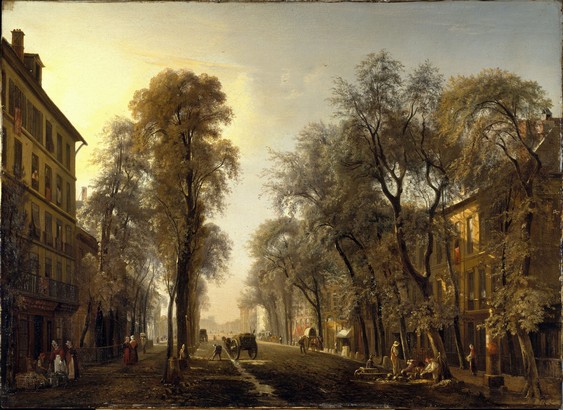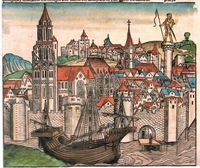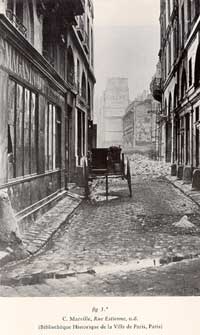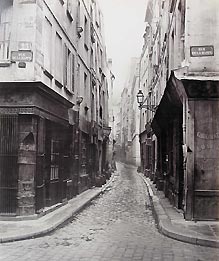David H. Pinkney, Napoleon III and the rebuilding of Paris (2)
Streets and Neighborhoods in the Old Paris

This Paris of 1850 betrayed centuries of existence behind a ring of fortified walls. The first fortifications, built by  Philip Augustus at the end of the twelfth century, enclosed only about 600 acres immediately opposite the islands on both sides of the river. In the next four centuries the walls on the Right Bank were twice moved outward, but by 1650 they were still only on the line of the present Rue Royale and the inner boulevards (the boulevards des Capucines, des Italiens, and the others that extend the line eastward to the Place de la Bastille), and enclosed but 1400 acres. Louis XIV, more secure than his predecessors, demolished much of the fortified wall, but a century later the government raised a new ring around the capital, this one not to protect the citizens of Paris against foreign enemies but to protect tax farmers against the Parisians. The farmers had contracted to collect the octroi, a levy on goods entering the city, and even in the eighteenth century Parisians were skillful at tax evasion. This "Wall of the Fermiers-généraux," broken by sixty gates, encircled Paris on the present second ring of boulevards, and in 1850 with but one minor change it still marked the legal limits of the city. In the 1840's a timid government fearful of the renewal of the anti-Napoleonic coalition against France threw a new ring of fortifications around the capital, but lying generally about a mile beyond the tax wall it was not yet confining in 1850.
Philip Augustus at the end of the twelfth century, enclosed only about 600 acres immediately opposite the islands on both sides of the river. In the next four centuries the walls on the Right Bank were twice moved outward, but by 1650 they were still only on the line of the present Rue Royale and the inner boulevards (the boulevards des Capucines, des Italiens, and the others that extend the line eastward to the Place de la Bastille), and enclosed but 1400 acres. Louis XIV, more secure than his predecessors, demolished much of the fortified wall, but a century later the government raised a new ring around the capital, this one not to protect the citizens of Paris against foreign enemies but to protect tax farmers against the Parisians. The farmers had contracted to collect the octroi, a levy on goods entering the city, and even in the eighteenth century Parisians were skillful at tax evasion. This "Wall of the Fermiers-généraux," broken by sixty gates, encircled Paris on the present second ring of boulevards, and in 1850 with but one minor change it still marked the legal limits of the city. In the 1840's a timid government fearful of the renewal of the anti-Napoleonic coalition against France threw a new ring of fortifications around the capital, but lying generally about a mile beyond the tax wall it was not yet confining in 1850.
The royal governments discouraged construction of buildings outside the city's walls, and as the population waxed, the city instead of expanding outward had grown by crowding ever more people into the central quarters. Houses were raised story above story. Gardens and open spaces were built over, courtyards omitted, little more than wagon tracks left for streets.
By 1850 the area within the inner ring of boulevards on the Right Bank, the seventeenth century line of fortifications, was an almost impenetrable hive of tenements and shops. Here in an area not twice the size of New York City's Central Park, piled one above another in rooms or tiny apartments, lived more than one-third of the city's one million inhabitants. The density of the population was higher than on the lower East Side of New York in the 1930's.2
This concentration of Parisians was more oppressive than one familiar only with twentieth century Paris might assume, for in 1850 few parks and open spaces relieved the overcrowding. In prosperous quarters private gardens, more common then than at present, offered some relief to the well-to-do, but there were no municipal parks except the dusty Champs Elysées and the Place des Vosges. A few nationally owned gardens were ordinarily open to the public: the south bank of the river had the Luxembourg Garden and the Jardin des Plantes, but on the Right Bank only the Tuileries Garden broke the built-up area, and it was on the edge of the heavily populated districts. The center and east end of Paris were without adequate public parks. The garden of the Palais Royal and the tree-lined boulevards provided touches of greenery in the city, but in 1850 many of the trees were gone, cut down in [the Revolution of] 1848 for barricades. The forty-eighters' subsequent ventures in tree planting, some one hundred "trees of liberty" scattered haphazardly about the city, were never a real replacement, and most of them had died before the spring of 1849.3
In the crowded areas enclosed by the inner boulevards of the Right Bank lay some of the city's worst slums. Late in the Empire the republicans blamed Napoleon III and his Prefect of the Seine, Baron Haussmann, for having created the slums of eastern Paris. Demolition of old houses in the central and western quarters had, they claimed, expelled the poor from these sections and concentrated them in the neglected eastern quarters and suburbs. Mixing memory with fancy they depicted Paris of the good old days before Napoleon III as a city where all social classes lived happily side by side in all parts of the city. Distinctions in wealth were reflected in the floors on which tenants lived, the poorer tenants occupying the lower-rent rooms on the top floors, the wealthy the large apartments on the second floor, and the moderately well-off the intermediate levels. A sense of solidarity united all the residents, and in times of distress the more prosperous tenants cared for the poorer.4 It was a pretty picture with a small measure of truth in it. The social differences between quarters had been less marked inParis than in London and perhaps other large cities, but the mixture of classes and fortunes was breaking down well before Napoleon III's time. An American resident observed in 1850 that in the high apartment buildings the tenants never knew their neighbors, and the English novelist, Edward Bulwer Lytton, had the same experience. Certainly the supposed mutual understanding had not prevented the bitter class warfare of June 1848.5
 Class quarters did exist in Paris at mid-century, and the poorest of them were dismal slums. In the crowded center of the city eastward from the Church of Sainte-Eustache and the Rue Montmartre rose a mass of ancient and decaying tenements, ordinarily five or more stories high, without courtyards, and with frontages of only some twenty feet. The streets werenarrow and winding. Many had no sidewalks, and they were usually wet from the open sewers that ran in the gutters. The sunlight seemed never to penetrate these dark caverns, and by
Class quarters did exist in Paris at mid-century, and the poorest of them were dismal slums. In the crowded center of the city eastward from the Church of Sainte-Eustache and the Rue Montmartre rose a mass of ancient and decaying tenements, ordinarily five or more stories high, without courtyards, and with frontages of only some twenty feet. The streets werenarrow and winding. Many had no sidewalks, and they were usually wet from the open sewers that ran in the gutters. The sunlight seemed never to penetrate these dark caverns, and by
night peaceful citizens avoided them. Here, especially in the streets near the Rue Saint-Denis, in miserable furnished rooms rented by the night lived the outcasts and the disinherited of Paris, men and women without fixed abode or occupation, living by theft and prostitution. Yet this same section of Paris was a part of the city's principal industrial district, whichextended eastward beyond the boulevards into the old faubourgs. From thousands of tiny shops and the dark rooms of piece-workers poured forth a stream of clothing, jewelry, artificial flowers, bronze and gold work famous throughout the fashionable world.6
But while these crowded quarters produced wealth they also bred disease and social unrest. The death rates here and in the slums of the southeast were the highest in the city. Here the epidemics of cholera that plagued Paris in the nineteenth century usually had their beginnings and their heaviest inci dence, and here were the strongholds of revolutionary resistance in 1830, in 1834, in 1839, and again in 1848.7
The entire east end of Paris was a working class district, and within this half of Paris the slums were not confined to  the area enclosed by the inner boulevards. The peripheral sixth and eighth arrondissements had sections of extreme poverty comparable to those around the Rue Saint-Denis, and the center of the Ile de la Cite between the Palace of Justice and the cathedral was another blemish on the city's face, a maze of dark and twisting streets. "The mud colored houses," wrote Eugene Sue, "broken by a few worm-eaten window frames, almost touched at the eaves, so narrow were the streets. Black, filthy alleys led to steps even blacker and more filthy and so steep that one could climb them only with the help of a rope attached to the damp wall by iron brackets."8 Fourteen thousand people lived within the narrow confines of the island, and, Sue recorded, it swarmed with "released convicts, thieves, murderers. When a crime is committed the police cast a net into these depths and almost always drag out the guilty persons."9 In the years of the cholera, 1832 and 1849, the death rate on this little island was exceeded in only two other quarters among the forty-eight into which Paris was divided.10
the area enclosed by the inner boulevards. The peripheral sixth and eighth arrondissements had sections of extreme poverty comparable to those around the Rue Saint-Denis, and the center of the Ile de la Cite between the Palace of Justice and the cathedral was another blemish on the city's face, a maze of dark and twisting streets. "The mud colored houses," wrote Eugene Sue, "broken by a few worm-eaten window frames, almost touched at the eaves, so narrow were the streets. Black, filthy alleys led to steps even blacker and more filthy and so steep that one could climb them only with the help of a rope attached to the damp wall by iron brackets."8 Fourteen thousand people lived within the narrow confines of the island, and, Sue recorded, it swarmed with "released convicts, thieves, murderers. When a crime is committed the police cast a net into these depths and almost always drag out the guilty persons."9 In the years of the cholera, 1832 and 1849, the death rate on this little island was exceeded in only two other quarters among the forty-eight into which Paris was divided.10
The fashionable residential districts were already in the western half of the city: in the neighborhood of the Rue de la Paix and the Rue de la Chaussee d'Antin and along the Rue Saint-Honore on the Right Bank and in the Faubourg SaintGermain across the river. Even these wealthy districts frequently adjoined surprising islands of slums. One lay between the Rue de Richelieu and the present Avenue de l'Op6ra, and just to the west of the present Gare Saint-Lazare around the Place de Laborde was a center of vagrants as bad as anything in the east end. Another slum had risen in the most unlikely spot of all-in the space between the Louvre and the courtyard of the Tuileries Palace.1l Balzac spoke of it as "one of those protests against common sense that Frenchmen love to make." Clearing of the area was started in 1849, but in 1850 most of it remained untouched. Balzac described the appearance of a part of it during the July Monarchy:
Beyond the little gate that leads from the Carrousel bridge to the Rue du Muste, anyone visiting Paris... is bound to notice a dozen houses with dilapidated facades, whose discouraged landlords have not troubled to repair them....
In passing this dead wedge and happening to notice the Impasse du Doyenne, one experiences a chilling of the soul, and wonders who could possibly live in such a place, and what goes on there at night, when the alley becomes an ambush, and where the vices of Paris, wrapped in the mantle of the night, are given full scope.12
"Our grandsons will refuse to believe," he added, "that such a piece of barbarism existed for thirty-six years in the heart of Paris...."